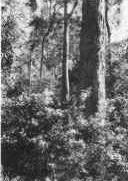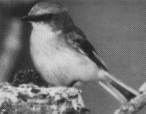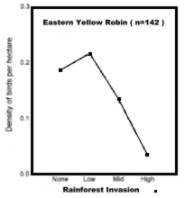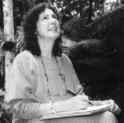
The CRC for Tropical Rainforest Ecology and Management
Northeast Queensland's Endangered
Wet Sclerophyll Forests
For the Birds? To many, bird watching is a pastime reserved for weekends and retirement. One of north Queensland's leading bird researchers makes it a daily event and in the process, has discovered valuable information about a shrinking landscape.
For the past three years, Angie Chapman, a University of Queensland PhD student, has been working in wet sclerophyll forest - bird watching.

Wet sclerophyll forest describes a narrow band of vegetation which, in northeast Queensland, occurs on the western edge of the rainforest above 600m. These forests grow in areas of high rainfall where rainforest would normally proliferate but the use of fire prevents the rainforest from invading. Scientists have documented a 50% loss of this forest type during the previous 50 years and many are worried that a complete take-over by rainforest could lead to the extinction of certain plant and animal species.
Wet Sclerophyll forest
invaded by rainforest
With new evidence that rainforests are invading the wet sclerophyll forests at an alarming rate, scientists are assessing the impact of rainforest invasion on the wet sclerophyll flora and fauna.
Before Angie's study, there was only limited information available about the birds of north Queensland's wet sclerophyll forests. "Birds in the southern wet sclerophyll forests (NSW and Victoria) are very well known, but virtually no information existed about the birds in the wet sclerophyll forests of this region," said Angie. "I was originally going to focus on a small number of species, but no knowing what was there in the first place made it rather difficult to start the study at all, " said Angie, "So this project is like opening a book for the first time."
Angie decided to concentrate on foraging behaviour so she could begin to understand how the birds were using the vegetation. Learning about the birds
"I didn't know which species were using wet sclerophyll, let alone which ones might be common," Angie admits, "or even whether some species were using it on a seasonal basis." While watching for birds, I made special note of their foraging behaviour. When birds forage we have absolute proof they are using the forest and not just passing through." Angie conducted surveys along 2km transects in wet sclerophyll forests from Davies Creek in the north to Koombooloomba in the south. Each survey encompassed varying degrees of rainforest invasion and different elevations. The differences between geographically separated species
Why is losing the wet sclerophyll forest in northeast Queensland of such concern, when this forest type remains common and free from threat in the south? Angie argues that in northeast Queensland the forest supports a different bird population from the southern wet sclerophyll forests.
South of Townsville there exists a dry corridor, called the Burdekin Cap, which acts as a barrier to animal movement between north and south. As a result, the species in the north are evolving separately from those in the south. One such species is the Eastern Yellow which has a genetically equivalent cousin south of the Burdekin gap. Although the birds look very similar they are recognised as a distinct sub-species.
"I'm especially interested in the endemic and genetically distinct birds," states Angie. "Is wet sclerophyll important to them or not?" Birds of Wet Sclerophyll Forest Angie's hours of "bird watching" revealed that although very few birds can be called wet
sclerophyll specialists (such as the Eastern Yellow Robin), the forest is very important for many species."Of the 100 species I recorded in these forests, one third are either endemic or are recognised as a separate subspecies," claimed Angie, "The wet sclerophyll forest supports a very rich assemblage of birds."
 Eastern Yellow Robin
Photo courtesy of
C and D Frith
Eastern Yellow Robins occur mainly in non-invaded wet sclerophyll. When foraging they perch on a vantage point a few metres off the ground and drop down to retrieve their prey. If the territory is invaded by rainforest, the ground is obscured and foraging is difficult.
"One of the things I found, is that as the rainforest invasion increases, the robins decrease" (see Figure 1)."Therefore rainforest invasion is a real threat to this endemic sub-species."
When times are lean in the rainforest
Angie's work also suggests that wet sclerophyll forests are important for some birds on a seasonal basis. The winter can be a lean time for many birds.
"The Bridled Honeyeater, is a rainforest endemic and my data show that the bird comes out of the rainforests in winter to forage in wet sclerophyll forests."
One commonly occurring tree in wet sclerophyll forest is Banksia integrifolia. This tree flowers in the winter and is therefore a very important nectar source for many birds.
White-cheeked Honeyeaters usually live in eucalypt woodland and heath but in this region, they are confined to higher altitudes and form a separate sub-species. They rely heavily on banksia nectar during the winter months.
When rainforest invades, banksia cannot germinate under the shade of the rainforest cover. Over time, the White-cheeked Honeyeater will decline and may not survive in this region.
Wet sclerophyll forest has many insect and nectar eating birds because of the large numbers of Allocasuarina sp. and Eucalyptus trees. Fruit-eating bird species are not well represented in wet sclerophyll forest.
 "I believe that the complete loss of wet sclerophyll habitat would spell trouble for some birds and would greatly disadvantage many others," declares Angie. "Fire management is required to create suitable foraging areas for the Eastern Yellow Robin and allow regeneration of the eucalypts and banksias upon which many other birds depend."
Figure 1: Effect of rainforest invasion
on Eastern Yellow Robins.
Diane Daly interviewed Angie for this story.
Angie's list of bird species in wet sclerophyll can be found on the world wide web at: www.cimm.jcu.edu.au/ rainforestCRC/products/infosheet.htm
For more information Contact: Angie Chapman
CSIRO Tropical Forest Research Centre
Atherton, Queensland, Australia, 4883
Phone: 07 40918800
Fax: 07 40913245
Ernail: angie.chapman@tfrc.csiro-au |  |
The CRC for Tropical Rainforest Ecology and Management is a formal partnership between the CSIRO, James Cook University of North Queensland, The University of Queensland, Griffith University and the Wet Tropics Management Authority.
P 0 Box 6811 Cairns Qld 4870 tel: (07) 4042 1246 fax : (07) 4042 1247
Web site:http://www.crctrem.edu.au Providing science for the conservation and management of Australia's World Heritage tropical rainforests. 
Return To Birdwatching Page
| 

